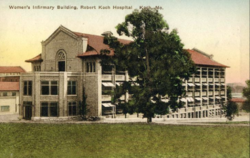Difference between revisions of "Robert Koch Hospital"
(Created page with "{{infobox institution | name = Robert Koch Hospital | image = MOkochPC.png | image_size = 250px | alt = | caption = | established = | construction_began = | construction_en...") |
(No difference)
|
Latest revision as of 00:37, 15 February 2025
| Robert Koch Hospital | |
|---|---|
 | |
| Opened | 1875 |
| Closed | 1983 |
| Demolished | 1989 |
| Current Status | Demolished |
| Building Style | Cottage Plan |
| Architect(s) | Barnett, Haynes, and Barnett |
| Location | Oakville, MO |
| Alternate Names |
|
History[edit]
The Robert Koch Hospital was located just off US 255 before it crosses the Jefferson Barracks Bridge in south county at 4101 Koch Road. The hospital was built by the city of St. Louis primarily as a quarantine facility for patients with a variety of easily transmissible diseases, including smallpox, yellow fever, and tuberculosis. There is a cemetery located on the grounds of this closed hospital, the building founded in 1875. The city expanded the site to include Quarantine Hospital, to quarantine and treat patients suffering from cholera, yellow fever and smallpox.
In 1910, it received the name Robert Koch Hospital, and its focus turned to tuberculosis and other infectious diseases. The dreaded tuberculosis, popularly known as TB, killed more residents than all other infectious diseases combined. The hospital provided free medical care to victims of the disease. The hospital at its peak had 19 buildings, its own post office, and even its own town, Koch, Missouri. The 19 buildings that survived to 1989 were all built between 1907 and 1939. It consisted of a 426-bed intermediate care facility, a 39-bed hospital, and a 166-bed residential-care facility.
The hospital expanded in 1920, 1933 and 1934 but still couldn’t keep up with demand. In 1939 the city made plans to expand the hospital to 1,000 beds to eliminate the waiting list, but couldn’t secure an appropriation from Congress to fund it. By the government’s own standards, the appropriate sizing for the hospital would have been 1,200 beds, due the the average number of deaths in the St. Louis area topping 600 at the time. Once cholera, smallpox, and yellow fever were no longer raging out of control in the city, Koch Hospital saw a second career treating tuberculosis.
The buildings that made up Robert Koch Hospital in St. Louis were generally a combination of Italian Romanesque and Italian Renaissance. Hospital design in the early 20th century needed to provide an attractive and appealing facade and landscape to convey a sense of hope, while retaining flexibility due to rapidly changing medical practices. After World War II, new drugs, including antibiotics, revolutionized the treatment of most infectious diseases. The hospital that was far too small in 1939 was bigger than it needed to be by the 1950s.
The city considered selling the hospital, then decided to repurpose it. It served as a type of nursing home from 1961 until November 1983, when it closed for good, and the city sold the perimeter acreage. In 1985, the city sold the remaining buildings to Bussen Quarries. The new owners demolished the buildings in 1989.


